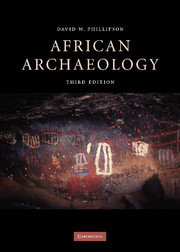Book contents
- Frontmatter
- Contents
- List of illustrations
- Sources of illustrations
- Preface
- 1 Introduction
- 2 The emergence of humankind in Africa
- 3 The consolidation of basic human culture
- 4 Regional diversification and specialisation
- 5 The beginnings of permanent settlement
- 6 Early farmers
- 7 Iron-using peoples before AD 1000
- 8 The second millennium ad in sub-Saharan Africa
- Bibliographic guide
- Bibliographic references
- Index
3 - The consolidation of basic human culture
Published online by Cambridge University Press: 05 June 2012
- Frontmatter
- Contents
- List of illustrations
- Sources of illustrations
- Preface
- 1 Introduction
- 2 The emergence of humankind in Africa
- 3 The consolidation of basic human culture
- 4 Regional diversification and specialisation
- 5 The beginnings of permanent settlement
- 6 Early farmers
- 7 Iron-using peoples before AD 1000
- 8 The second millennium ad in sub-Saharan Africa
- Bibliographic guide
- Bibliographic references
- Index
Summary
Acheulean and Sangoan in Africa
This chapter deals primarily with one of the most remarkable and least understood phenomena of world prehistory: the enormously wide distribution, both in time and space, of people who made stone artefacts of the type conventionally known to archaeologists as ‘Acheulean’. (Problems of definition are considered below.) These artefacts first appeared in the archaeological record, in eastern Africa, about 1.6 million years ago; and they seem to have survived in most areas until the period between 350,000 and 250,000 years ago: a time-span of at least 1.25 million years. In addition to Africa, Acheulean-type artefacts are found in Europe and Asia, from Spain and Britain in the west and north, to India and perhaps China in the east. In some parts of the Old World they are the oldest known manifestation of human settlement (but see Carbonell et al. 1999). The name is taken from Saint Acheul in the Somme Valley of northern France, one of the places where these characteristic stone artefacts were first recognised during the mid-nineteenth century. Also discussed here, because they are seen as a final manifestation of the Acheulean tradition, are the African stone-artefact assemblages designated Sangoan after Sango Bay on the western shore of Lake Victoria (cf. G. H. Cole 1967).
Although the Acheulean has often been regarded as an entity, there are good reasons to believe that this long period was one during which important human behavioural developments occurred in the conceptual, social and organisational fields, as well as in the more readily discernible technology (J. D. Clark 1996).
- Type
- Chapter
- Information
- African Archaeology , pp. 52 - 90Publisher: Cambridge University PressPrint publication year: 2005
- 1
- Cited by



